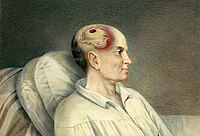
Photo from wikipedia
The aim of the study was to investigate the occurrence of balance disorders in children after mild head trauma.Ninety patients after mild head trauma, aged 7–18 years, were examined on… Click to show full abstract
The aim of the study was to investigate the occurrence of balance disorders in children after mild head trauma.Ninety patients after mild head trauma, aged 7–18 years, were examined on a stabilometric platform 48 h and 12 weeks after injury. The results were compared with 50 healthy children. Seven selected parameters of the stabilogram were measured and analyzed.Children hospitalized after head trauma represented 3.78% of all surgical admissions and 6.6% of all patients after head trauma reporting to the emergency department. The values of all parameters in the entire study group 48 hours after injury were significantly higher than 12 weeks later (p < 0.03), when they decreased to the level of the values in the controls. An inverse relationship between the value of each parameter and the child’s age, both in the study group 48 h after injury (p < 0.014) and in the controls (p < 0.008), was found. The values of all parameters in children of the study group aged 11–15 years 48 h after the injury were significantly higher than 12 weeks later (p < 0.05), and significantly higher than in the controls (p < 0.05). The best indicators describing disorders and normalization of body balance control processes were the total path length of center of pressure (SP-EO), the average center of pressure deflection (MA-EO) and the average center of pressure sagittal deflection (MAAP-EO).Minor head trauma clearly, though temporarily, disturbed body postural control, especially affecting children aged 11-15. However, all examined patients 3 months after injury controlled the body balance, like their healthy peers.
Journal Title: Archives of Medical Science
Year Published: 2019
Link to full text (if available)
Share on Social Media: Sign Up to like & get
recommendations!